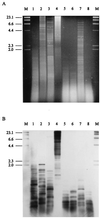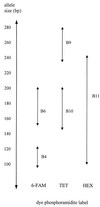Identification of Epichloë endophytes in planta by a microsatellite-based PCR fingerprinting assay with automated analysis
- PMID: 10049893
- PMCID: PMC91174
- DOI: 10.1128/AEM.65.3.1268-1279.1999
Identification of Epichloë endophytes in planta by a microsatellite-based PCR fingerprinting assay with automated analysis
Abstract
Epichloë endophytes are a group of filamentous fungi that include both sexual (Epichloë) and asexual (Neotyphodium) species. As a group they are genetically diverse and form both antagonistic and mutualistic associations with temperate grasses. We report here on the development of a microsatellite-based PCR system for fingerprinting this group of fungi with template isolated from either culture or infected plant material. M13mp19 partial genomic libraries were constructed for size-fractionated genomic DNA from two endophyte strains. These libraries were screened with a mixture of DIG-labeled dinucleotide and trinucleotide repeat probes. Positive clones were sequenced, and nine unique microsatellite loci were identified. An additional microsatellite was serendipitously identified in the 3' untranscribed region of the 3-hydroxy-3-methylglutaryl coenzyme A (HMG CoA) reductase gene from N. lolii Lp19. Primers were designed for each locus and a panel of endophytes, from different taxonomic groupings, was screened to determine the degree of polymorphism. On the basis of these results a multiplex assay was developed for strain identification with fluorescently labeled primers for five of these loci. Using this system the size of the products amplified can be precisely determined by automated analysis, and an allele profile for each strain can be readily generated. The assay was shown to resolve endophyte groupings to the level of known isozyme phenotype groupings. In a blind test the assay was used successfully to identify a set of endophytes in planta. A reference database of allele sizes has been established for the panel of endophytes examined, and this will be expanded as new strains are analyzed.
Figures







References
-
- Arachevaleta M, Bacon C W, Hoveland C S, Radcliffe D E. Effect of the tall fescue endophyte on plant response to environmental stress. Agron J. 1989;81:83–90.
-
- Bacon C W, Lyons P C, Porter J K, Robbins J D. Ergot toxicity from endophyte-infected grasses: a review. Agron J. 1986;78:106–116.
-
- Boehringer Mannheim GmbH. The DIG system user’s guide for filter hybridization. Mannheim, Germany: Boehringer Mannheim GmbH; 1995.
Publication types
MeSH terms
Substances
Associated data
- Actions
- Actions
- Actions
- Actions
LinkOut - more resources
Full Text Sources
Other Literature Sources
Research Materials

